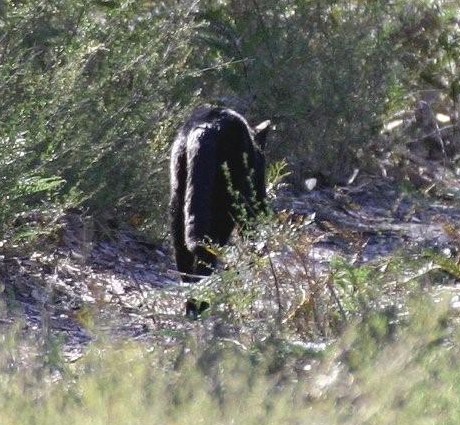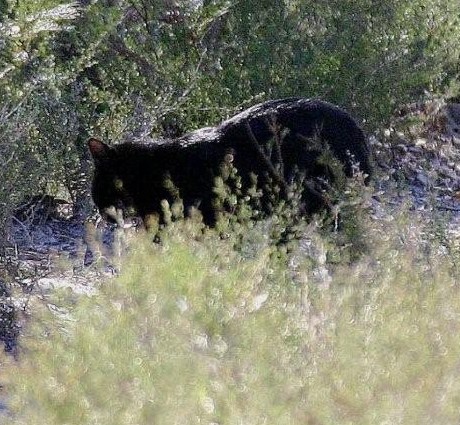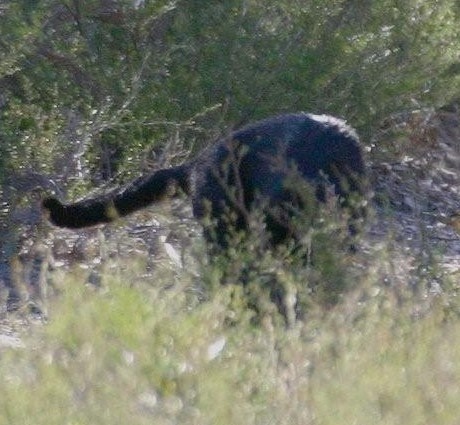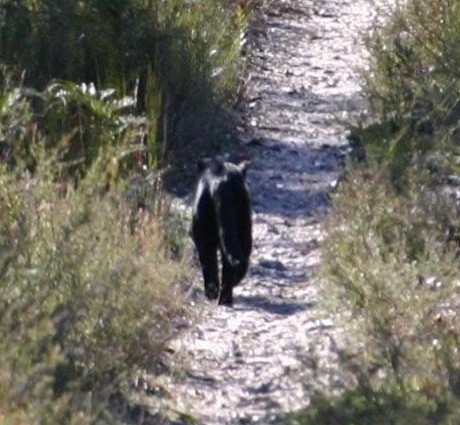Pussy or Puma?
Posted by: Loren Coleman on February 27th, 2007
Images of an Australian mystery puma or a domestic housecat? The following photographs were found to have been taken three years ago, and forgotten about, as far as being developed, until recently. They are “Copyright (c) R. McPherson 2007,” used with permission.
The person taking them claims: “The photos show a large black cat as [big as?] a puma! about 35kg +, 70cm high, tail alone would be 70cm long and about 70mm diameter, body with out tail would be about 90/100cm long ; has the right colored eyes etc; They were taken in outback of Casterton forest towards Penola Rd in forest where we used to take redtail black cockatoo photos.”
What do you think? No reason to bias you with my reaction, but I bet you can guess.






About Loren Coleman
Loren Coleman is one of the world’s leading cryptozoologists, some say “the” leading living cryptozoologist. Certainly, he is acknowledged as the current living American researcher and writer who has most popularized cryptozoology in the late 20th and early 21st centuries.
Starting his fieldwork and investigations in 1960, after traveling and trekking extensively in pursuit of cryptozoological mysteries, Coleman began writing to share his experiences in 1969. An honorary member of Ivan T. Sanderson’s Society for the Investigation of the Unexplained in the 1970s, Coleman has been bestowed with similar honorary memberships of the North Idaho College Cryptozoology Club in 1983, and in subsequent years, that of the British Columbia Scientific Cryptozoology Club, CryptoSafari International, and other international organizations. He was also a Life Member and Benefactor of the International Society of Cryptozoology (now-defunct).
Loren Coleman’s daily blog, as a member of the Cryptomundo Team, served as an ongoing avenue of communication for the ever-growing body of cryptozoo news from 2005 through 2013. He returned as an infrequent contributor beginning Halloween week of 2015.
Coleman is the founder in 2003, and current director of the International Cryptozoology Museum in Portland, Maine.










That’s no puma. The cat in this photo is obviously a fine specimen of Felis catus.
As to the size, without knowing the actual size of the plants surrounding it, it’s hard to say for sure. The photos appear to be cropped, so there’s really nothing like trees, etc., with which to compare the size of the cat. Judging from its bodily and head proportions, it does not look unusually large. In photos 1,2, and 3, individual hairs in the cat’s fur are backlit and you can compare them to the size of the cat’s body. They appear to be proportionate to a domestic cat of average size.
As I am looking at these photos I am watching my jet-black cat, Halloween, walking across the edge of my yard. Comparing them, I don’t see anything in these photos that leads me to believe the cat is anything other than a domestic cat, and nowhere near as big as a puma. There’s no way to tell from the photo whether the cat it tame or feral, of course, but it looks like a pussycat out for a stroll.
I’m with kittenz on this one, she knows cats. Although I must admit when I saw the first photo it did give the impression of something larger than a normal cat. The rest though just look like a kitty.
I too would agree that this is just an ordinary housecat. Everyone is looking for something to compare the size of the cat to. Just look at the trail itself. If this is an ordinary animal path its probably no more than 12-16 inches across. That makes the cat about average for a house cat.
I think the second to last photo is the give away…just the head and neck dont look right for a big cat….just a plain old pussy cat.
My instant take: Felis catus, normal size. I think the plants along the side of the road give ample scale. They may not be American species, but they have relatives here.
And I should add “not that this thing looks remotely like anything but a domestic cat.”
And I should also add:
1. Was this a quiz or something? Is this a Recurring Cryptomundo Feature, the Cryptid Quiz?
2. Oz really DID evolve without cats, dinnit.
Oh. One more thing.
Clear photo! CAN’T be a cryptid! 😀
LOL Good point DWA !
Nice house cat. Nothing more.
Besides the fact that everyone else thinks its a cat. The angle of the pictures and the thickness of the plants compared to the size of the plants makes the cat look very small. Also the clarity of the pictures gives me the impression that the pictures were taken from not that far away.
At least its not photoshopped.
House cat!
I can’t believe they would claim otherwise.
Anybody know what kind of plants those are so we can maybe get a better size estimation? Right now, I would have to say that those are nice photos of someone’s cat and not even a particularly large specimen.
House cat.
The Aussies have quite a sense of humour so I’m thinking this might be a joke.
It also serves to remind us that if any of us ever get a real picture please take one zoomed out so we can get a good perspective of size.
By the way, maybe a picture of a real puma could be kept handy to post along side pix like this just so we have a comparrison of body shape, etc.?
??
If the pictures showed anything other than a black house cat (which they don’t) it wouldn’t be a puma. No black puma has ever been documented. Of course, “puma” works with the alliteration thing going on here.
Since folks have called dead black dogs and live black cats cryptids, maybe it’s time for somebody to take a picture of a turkey vulture and claim it as a thunderbird.
Oh yeah, that’s been done too.
This is most certainly a plain old house cat. I think my 20 pound black cat is much bigger than this fellow.
I agree – it’s definitely a domestic cat. There’s nothing in the animal’s proportions (especially the tail:body) that suggests “puma.”
Its certainly a very large male Domestic Cat.This specimen must be a good 17-18 pounds.
SEBigfoot2007:
Indeed. A whopper. Clearly capable of taking on an adult Yowie on its best day. You might not even have to open the can of NineLives for this monster. Just give it the can and back away slowly if you value your life.
Thylacoleo carnifex: Live In Fear.
Here Kitty, Kitty, Kitty ! If that is a normal animal trail then that’s a normal sized kitty-cat. Sylvester in search of Tweety.
I’m with you all … there’s no roar in that meow.
Black kitty…
Just a plain old kitty kat.
Its just a feral cat.
Lots of them in Australia.
They are devastating to the local wildlife
and should be eradicated.
Hunters shoot them on site.
This one seems to be average to slightly above average size.
Pussy, and not a large one. Not underfed, but not overweight either, chances are this is the photographer’s housecat. A feral cat wouldn’t be that well fed, and wouldn’t be so calm near a human.
No mystery here. It’s a cat! 🙂
feral cat
they regularly reach 30kg by gorging themselves on Australian native wildlife with bone and muscle structure in proportion. A researcher I met once said he had to use a .222 Remington to harvest specimens humanely – but occasionally freak specimens would only be wounded rather than killed outright
Felis concolor:
Puma, mountain lion, cougar.
Having met one in the wild, close up and personal, it sure didn’t look like this kitty!
Hollis
At a glance, yes, it looks like a cat. All the same, I’m not super familiar with bigger cats.
The track does look to be about 12 to 18 inches wide as someone wrote, and very typical of a bush track. A week ago I walked about 12 miles through the Royal National Park south of Sydney, on tracks like this, through bush and on fire trails. Fire trails are very much wider and look very different in colouration and texture, which is what leads me to agree on the 12 to 18 inches wide theory… which of course implies: housecat.
Meow.
Chris.
Now, THAT is a felis catus of good size. Not as big as a German Shepherd, but a respectable pusscat in his own right. Reminds me of my old Sealpoint cat, Mooch, in form. He was a big one, but most definitely not as big as a puma. He could make you THINK he was if your foot twitched under the covers, though! That tail is a dead giveaway; a puma’s tail is loooooooong and fluffy.
“Clear photo! CAN’T be a cryptid!”
DWA, you just made my day!
He looks just like my cat, Orion. The only thing even remotely big cat-like (Other than being a cat, of course) is the tail, which seems just a little bit thicker than normal, but still not freakish by any stretch of the imagination. I’ve seen many a black-coated feral cat, and, while not normally dirty or matted, their coats could best be described as “dull” and somewhat unkempt. I would highly doubt that this is a feral cat, as his coat seems too well-groomed and shiny.
There seems to be some misconception about feral cats. They are not always the scrawny, unhealthy creatures that you see scavenging around garbage dumpsters.
There is a difference in feral cats that live like wild animals, out to themselves in the forest or bush, and feral cats that have a sort of semi-tame existence on the fringes of human society.
Feral cats that live in the wild are ususually more solitary, and often quite healthy. Their lifestyle is more like that of a wildcat than a domestic. Their population density in any given wild area is not so dense as that of ferals who have a semi-steady food supply. Many of the “wild” feral kittens do not survive, mainly because other predators take them as prey. There aren’t a lot of scrawny, sickly adults, because the unhealthy ones just do not usually survive to maturity. The toms, especially, get scarred from fights and often suffer from abcesses due to infected wounds, but they either heal quickly or die. Since these “wild” feral cats eat whole animal food and not garbage, they do not suffer the nutritional deficiencies that more urban ferals do. Cats living wild tend to have much shorter, more violent lives, and they rarely ever die from old age, but they are often the picture of feline health.
Please don’t take this as an advocation of allowing feral populations to fluorish. I advocate no such thing, and I believe that pet cats should be surgically sterized. I support neuter-and-release programs for strays and ferals. Those programs are great because they not only prevent existing ferals from reproducing, but by releasing the neutered cats back into their territory, it helps to prevent other cats from moving into that territory. Eventually, feral populations could be nearly eliminated in this way (but it is expensive).
The main problem with feral cats is that they have to kill small animals to survive, and they are super-predators that can out-compete native predators in many cases, and they also are very prolific breeders, so they can quickly overwhelm fragmented or isolated populations of small prey, which have evolved no real defenses against them.
Kittenz, you raise a very good point about a feral cat’s ability to out compete indigenous predators of any given area. They are a highly successful predator as well as hardy and adaptable to a wide range of ecosystems. They can be handy ratters, but what happens when rats aren’t enough? There have been instances in the past where cats were purposefully introduced to reign in a vermin problem, but the cats ended up turning to more varied prey which often included unprepared native species. There are a lot of places where the common feral cat has caused a lot of trouble, not only from pushing out the native predators, but wiping out indigenous creatures that have no defenses against the onslaught. I wholy agree with programs to sterilize and release strays and ferals.
I wasn’t suggesting that he couldn’t be feral because he looked healthy, as I agree I’ve seen many who seem in the peak of health. What I was saying is that because they are outside, their coats tend to be “duller”, or perhaps dustier might be a better term. Not dirty, but just a little more dusty and “lived-in”, if that makes any sense.
I have always loved cats, not the least because they were probably the more dependable half of my family growing up, and in my estimation far more trustworthy. I would never do anything to harm one, yet I agree that they can pose an ecological hazard in some environments, particularly small islands. In those cases, I fully support their removal by any means necessary.
Aside from a few dinosaurs and sharks, whose repuutations I suspect have more to do with Hollywood than reality, I think cats, both big and small, represent this planet’s supreme Uber-predators. When I hear tales of the world’s smallest feline (Felis nigripes, or the Black-Footed Cat) being able to take down giraffes, I can almost believe it.
yeah, regular house cat. Pics 2,3 and the last proved it to me. 2 & 3 we see a rather short (in length) critter playing with something the way a house cat would. The last, just look at the pelvis, not big enough to be anything else. Besides, I think I would finish off the role of film right away if I was sure this was something as big as a puma in Australia.
Mnynames,
You are absolutely right about the wild or feral cats’ coats looking dusty. Although I have not seen it described formally, my own observation of cats over many years is that cats take dust baths, much the same way that chinchillas do. When pet cats roll around on their backs in sand or gravel, people usually think that they are just being playful. But play behaviors always refer back to some other more basic, necessary behavior. It isn’t just tame pet cats that exhibit the rolling behavior; small wildcats from arid areas do that too.
I think that the rolling behavior cleans and fluffs the cats’ fur, and possibly disguises the scent to a degree, by making the cat smell like its surroundings. Maybe the dusty appearance even has its own survival value, causing the coat not to be very shiny and reflective. The dust or sand probably also helps to rid the cat of parasites like fleas by acting as a dessicant.
same cat that was in decatur illinois a black house cat and probaly the same thing they see in exmoor